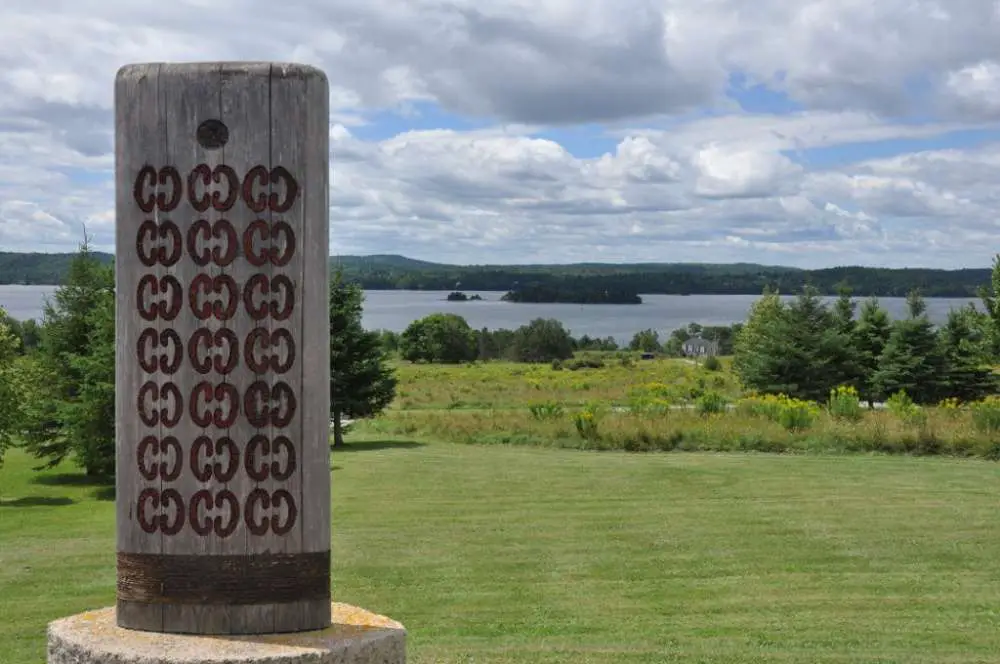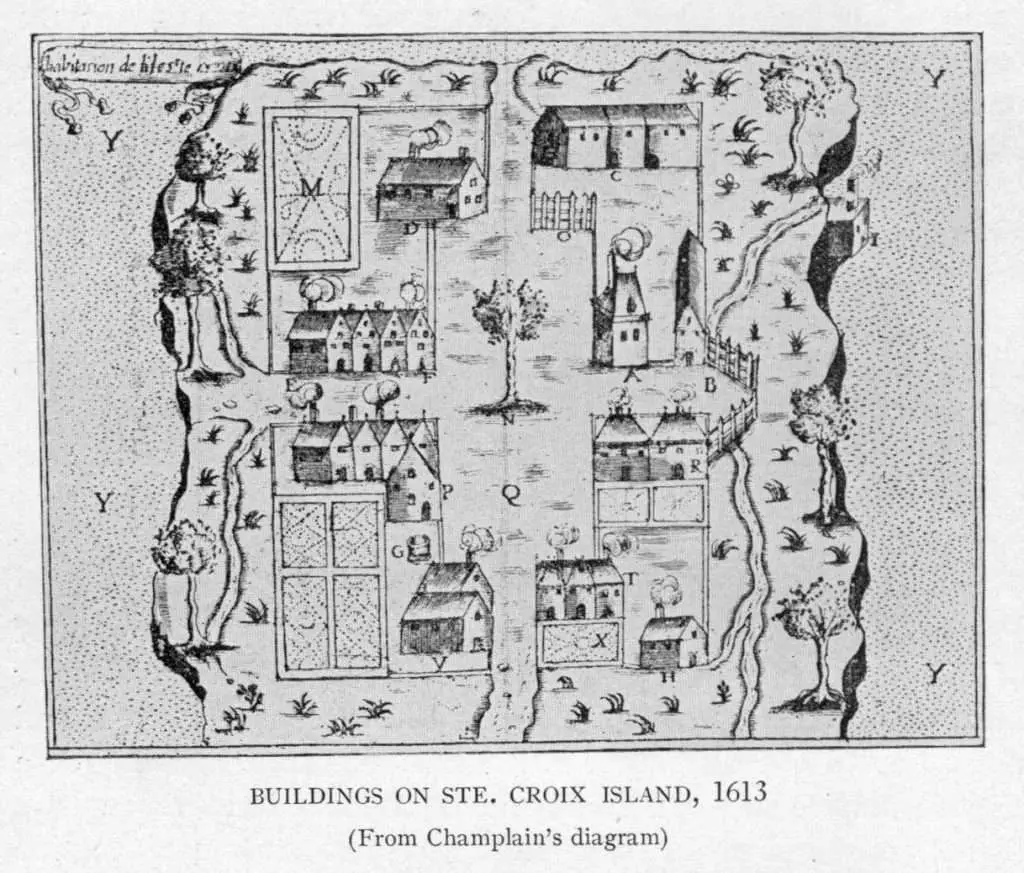Sixteen years before the Pilgrims stepped on Plymouth Rock, French adventurers settled St. Croix Island in a river that divides Canada from the United States.
They thought they found a paradise, with warm weather, good soil, plenty of fish and deer and easy access for shipping.
Then winter came, and most of the men were felled by a hideous, mysterious disease. Had the weather not been so severe, or if the men had Vitamin C, New England might be New France today.
The settlement only lasted a year. Historians, though, consider St. Croix Island the real beginning of the permanent European settlement of Canada.
St. Croix Island
In 1604 Pierre Dugua, a French nobleman, organized a company of men that included young Royal Geographer Samuel de Champlain and Champlain’s uncle, Francois Grave Dupont. Dugua intended to colonize North America and trade with the Indians for furs.
The company was an odd mixture of artisans and sailors, thieves, ruffians, courtiers and merchants. Some were Catholic, some were Huguenot. As soon as the ship set sail from France, fights broke out over religion.
Champlain was entertained by the fighting. “I forget just now which was the hardest hitter, but leave you to imagine what a fine spectacle they made,” he wrote. They aimed and dodged blows as the sailors watched and backed them according to their sectarian prejudices. Some shouted, ‘Hang the Huguenot,’ and others ‘Down with the Papist.’
In June they arrived at the tree-covered island in the mouth of the St. Croix River. They chose it because it offered protection from Indians and the English, who were also seeking a foothold in North America. “Vessels could pass up the river only at the mercy of the cannon of the island,” wrote Champlain. They determined the soil was good and they could trade with the Indians.
“Here seemed to be a Paradise,” wrote Champlain.
Dupont returned to France. The men who remained built a barricade and positioned their cannon inside it. Years later, cannonballs were found on the island.
They immediately began building houses, an oven and a hand mill for grinding wheat. They also planted rye, which grew as good as the rye grown in France.
Inside the fort they built a house for Duqua of sawn wood from France. Dugua flew the French flag over it.
The Indians came to look at the ways of the French, and even asked Duqua to judge their disputes.
Death and Disease
Winter came sooner than expected. It began to snow on October 6, and the cold was sharper and longer than winter in France. Many of the men were struck by a strange disease. Great pieces of superfluous flesh were produced in their mouths so they could take nothing but liquid. Their teeth got so loose they could be pulled out without pain. They couldn’t walk and had no strength. The majority could neither walk nor move.
They called the dreaded disease ‘mal de la terre.’
Thirty-five of the party of 79 died and more than 20 were on the point of death. They were buried in the cemetery shown on Champlain’s map. Years later their bones were exposed by erosion and taken to be analyzed. They showed signs of scurvy, which they probably contracted because they ate nothing but salted food.
There were no springs or brooks on St. Croix Island, so they drank melted snow. They couldn’t get to the mainland because of the ice in the river.
Finally spring arrived in May, and the sick men began to heal. On June 15, they heard the splashing of oars in the water. It was Dupont, with two ships filled with fresh supplies.
Exit from St. Croix Island
Dugua decided to find a more hospitable site for a colony. Champlain and Dupont spent six weeks exploring the coast, venturing as far as Cape Cod. They decided to move to a spot they called Port Royal, which is now Annapolis, Nova Scotia. Under Champlain’s supervision, the men dismantled their houses, loaded them on two barques and floated them across the bay to Port Royal.
For nearly 200 years St. Croix Island slipped out of written history. Then in 1794, Great Britain and the United States settled a boundary dispute and determined St. Croix Island belonged to the United States.
It became known as Bone Island in the 18th century after many of the graves were exposed. Then in the War of 1812 it earned the nickname Neutral Island because it didn’t take sides. It has also been called Demont’s Island, Doucett Island and Dochet Island.
Today, St. Croix Island is near the Maine town of Robbinston. In 1984, the U.S Congress designated it as Saint Croix Island International Historic Site. No one lives there.
Photos: St. Croix Island, By Jerrye & Roy Klotz, MD – Own work, CC BY-SA 4.0, https://commons.wikimedia.org/w/index.php?curid=37100192. St. Croix Island from New Brunswick By User:Magicpiano – Own work, CC BY-SA 4.0, https://commons.wikimedia.org/w/index.php?curid=18864900. This story last updated in 2023.




7 comments
[…] can claim perhaps the best of Christmas firsts: the first Christmas, in 1604. It happened on St. Croix Island, the lost French colony of […]
[…] can claim perhaps the best Christmas first: the first Christmas, in 1604. It happened on St. Croix Island, the lost French colony of […]
[…] got its start in 1630, the first settlement in Maine to survive. Two others, Saint Croix Island and the Popham Colony didn’t last long. For nearly a century Berwick was a parish of Kittery, […]
[…] French failed to colonize, too, on the island of St. Croix in the river that divides Canada from the United States. Seventy-nine men arrived in the summer of […]
[…] levantamentos da região identificaram os melhores locais possíveis para os assentamentos.(8) A ilha parecia ideal: Bem defendida tanto pelos nativos quanto pelos ingleses, só podia ser […]
[…] considerable surveying of the region had identified the best possible locations for settlements.[8] The island seemed ideal: Well-defended from both the natives and the English, it could only be […]
[…] “St. Croix Island, The Lost French Colony of Maine.” New England Historical Society, 24 June 2016, https://newenglandhistoricalsociety.com/st-croix-island-lost-french-colony-maine/. […]
Comments are closed.